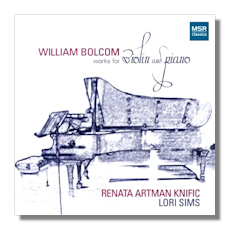
The Internet's Premier Classical Music Source
Related Links
- Bolcom Reviews
- Latest Reviews
- More Reviews
-
By Composer
-
Collections
DVD & Blu-ray
Books
Concert Reviews
Articles/Interviews
Software
Audio
Search Amazon
Recommended Links
Site News
 CD Review
CD Review
William Bolcom

Music for Violin
- Third Sonata Sonata Stramba (1992)
- Second Sonata (1978)
- Fourth Sonata (1994)
- Graceful Ghost Rag – Concert Variations for Violin & Piano
Renata Artman Knific, violin
Lori Sims, piano
MSR Classics MS1197 57:20
Summary for the Busy Executive: Elegant subversion.
William Bolcom began studying composition barely into his teens with John Verrall at the University of Washington. As an undergrad, he learned from Darius Milhaud at Mills College. Like most composers of his generation, he first started writing dodecaphonically, but the eruptions of popular culture during the Sixties caused a radical transformation of his style. Bolcom became hipped on ragtime and classic popular song, this enthusiasm showed up in his music. He had hard notices from the new-music crowd, who probably resented more than anything else that the music sounded so damn good.
Bolcom has said that his earliest musical pleasures were the sounds of the violin and of the human voice. He schooled himself to become one of the few pianist-composers to write idiomatically for strings. Violinist Erich Friedman once pointed out, for example, that Beethoven's solo violin parts lay better for a pianist's right hand than for a violinist's left. On the other hand, string players regularly complement Bolcom on his string writing.
In 1978, Bolcom wrote the beautiful Second Sonata (and I believe the 1983 violin concerto as well) for violinist Sergiu Luca. Unlike most classically-trained violinists, Luca admired jazzers like Joe Venuti and Stuff Smith, which was just fine by Bolcom, who incorporated jazz elements into the work. When you consider the times, the score dared much, far from either the trendier minimalism or the academically-dominant post-Webernian serialism of the era. The first movement, a slow quasi-blues, lopes along, with an outburst along the way. The second movement, a scherzo marked "Brutal, fast," lives up to its label. The ensuing slow movement begins in an arrhythmic, near-atonal sea, typical of Seventies music. Bolcom differs from others in that he gives it and effective dramatic shape, and it soon becomes apparent that the music is struggling to tonality. By its end, it has morphed into a hymn of unusual beauty. The finale, "In Memory of Joe Venuti," takes a bone-simple chord progression and an infectious Latin-jazz rhythm, calling to mind Bolcom's cabaret song "Amore." The gears momentarily come loose, but in the final measures, the little riff peeks through the curtain and winks.
The Third Sonata, "Sonata Stramba," emphasizes intensity and contrast. Fittingly, Bolcom wrote it for Nadia Salerno-Sonnenberg. The first movement, a highly idiosyncratic sonata, declaims, broods, and rails. The slow second movement sings. The third movement, a scherzo, starts and finishes in – poof! – the blink of an eye and leads to the finale, a kind of tango, which I believe gives the sonata its sobriquet. It takes one eight- or nine-bar phrase (depending on how you count) to the point of obsession. Indeed, during its first three minutes, it doesn't change tonality. Gradually, it begins to slip its anchor and to take off for harmonically perverse seas, always sailing on its initial idea, until it finds its way to its tonal home again.
The Fourth Sonata is probably the best-written and my least favorite. Part of the problem with Bolcom's eclecticism is that it can blur the aesthetic focus of a work, as I think the case here. The opening "Allegro brillante" reminds me a little of Milhaud. I don't know what to make of the slow second movement, "White Night." However, by the third movement, "Arabesque," I'm back on firmer ground. It reminds me of North African music – a single-line chant intoned over and over, until it spills over into the fourth movement, a Spanish jota. At one point, the chant comes back, emphasizing the kinship between Moorish and Spanish culture.
Bolcom's Graceful Ghost rag, counts as a minor hit. It breathes a lovely, refined air, eschewing the too-fancy for a firm belief in simple, clear ideas. Knific and Sims give an elegant performance.
I like the collection of most of Bolcom's violin sonatas in one spot, and the performances come over as musicianly. Both Knific and Sims understand the fit between the violin and the piano in the sonatas. Ensemble is superb. In the Second Sonata, I do prefer Sergiu Luca and (if my memory hasn't failed me) Bolcom at the piano – more poetry. However, the Third Sonata gets a fiery, furious reading. Knific and Sims fill the finale with menace. The disc is a gift to Bolcom's fans and a decent introduction to newcomers.
Copyright © 2009, Steve Schwartz




















